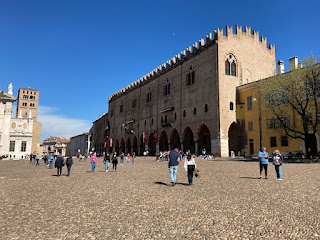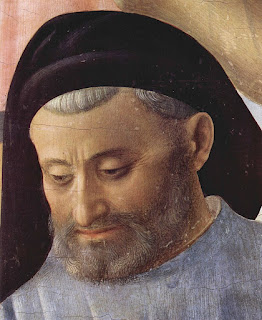Artist worked for three successive Medici Grand Dukes in Florence
Giambologna, the last in the line of significant Renaissance sculptors, died on this day in 1608 in Florence.
Giambogna's Abduction of a Sabine
Woman in Piazza della Signoria
He was considered so important by the Medici family that once he had started working for them, they would never allow him to leave their city. They feared he would be enticed away by either the Austrian or Spanish branches of the Habsburgs to work for them.
His best known works include Abduction of a Sabine Woman - often known as Rape of the Sabine Women - in Florence’s Piazza della Signoria, and his Neptune, atop the Fountain of Neptune, in Bologna’s Piazza Maggiore.
Although influenced by Michelangelo, Giambologna produced many beautiful works in marble and bronze in his own late-Mannerist style, with perhaps less emphasis on emotion, and more on the elegance of the figures.
The sculptor was also sometimes known as Giovanni da Bologna, or Jean de Boulogne in French, and Jehan Boulongne in Flemish.
Giambologna had been born in Douai in Flanders in 1529, which was then part of the Netherlands, but is now part of France. He studied in Antwerp with the architect and sculptor Jacques du Broeucq, before moving to live in Italy in 1550.
There, he made a detailed study of the sculptures of classical antiquity in Rome. His first major commission was given to him by Pope Pius IV, who employed him to sculpt the colossal bronze Neptune and subsidiary figures, for the Fountain of Neptune in Bologna.
Giambologna moved to live and work in Florence in 1553. He had become established there within a few years and he was invited to become a member of the Accademia delle Arti del Disegno after it was founded by the Medici Duke, Cosimo I, in 1563, who was influenced by the painter and architect Giorgio Vasari.
 |
| Giambologna was so prized by the Medici he was forbidden to leave |
His marble sculpture Abduction of a Sabine Woman still stands in the Loggia dei Lanzi in Piazza della Signoria. The work includes three full figures and yet it was carved from a single block of marble. It was produced for Francesco I de’ Medici, Grand Duke of Tuscany.
The sculpture was inspired by a story from ancient Roman history of the mass abduction of women from other cities for the purposes of growing the population of Rome which, at the time of its foundation, had relatively few female inhabitants. The Latin word raptio, which occurs in accounts of the incident written by the Roman historian Livy, can be translated as ‘rape’ in certain circumstances, but in this context may more accurately be taken to mean ‘abduction’ or ‘kidnapping’.
Giambologna’s several depictions of Venus produced a canon of proportions for the female figure, and also set standards for artists making Venus their subject that were to influence many future sculptors in Italy and Europe.
He also produced sculptures and ornaments for the Boboli Gardens in Florence and the gardens of other Medici villas in Tuscany.
His pupils went on to influence other sculptors throughout Europe as well as in Italy. Giambologna’s style, which incorporated grace, strength, and movement in his figures, anticipated the Baroque sculptures that were later created by Gian Lorenzo Bernini.
After he died in Florence at the age of 79, Giambologna was interred in a chapel that he had designed for himself in the Basilica della Santissima Annunziata in the centre of the city.
He had been an Italian sculptor in all but birth, who had left his mark on Florence and helped to make it the refined, elegant city it is today.
Travel tip:_03.jpg)
The Loggia dei Lanzi in Piazza delle Signori
houses a number of important statues
Giambologna’s most famous work, the marble sculpture Abduction of a Sabine Woman, stands in the Loggia dei Lanzi on the south corner of the Piazza della Signoria in Florence, close to the Uffizi gallery. The 14th century Loggia is named after the Lancers, who were the bodyguards of Cosimo I de’ Medici and it now provides an open air sculpture gallery for visitors to Florence to enjoy. The back wall of the Loggia is lined with ancient Roman statues of priestesses. On the far left of the Loggia is the bronze statue of Perseus by Benvenuto Cellini. Giambologna’s Abduction of a Sabine Woman, stands on the far right. Including three separate figures, it is believed to have been worked from the largest block of marble ever to have been transported to Florence and it was designed so that it can be appreciated equally from all sides. It has stood in the Loggia since 1583. A plaster cast model of the sculpture can also be seen in the Accademia Gallery in Florence.
Travel tip: 
The Basilica della Santissima Annunziata in
Florence, where Giambologna was buried
Giambologna was laid to rest in the Cappella della Madonna del Soccorso in the Basilica della Santissima Annunziata, the mother church of the Servite Order, in Piazza Santissima Annunziata in Florence. The sculptor designed the chapel between 1594 and 1598 for his own tomb and it is richly decorated with frescoes and statues. The most important work in the chapel is the large bronze Crucifix by Giambologna, showing the dead Christ with his head reclining and his eyes closed. It towers over everyone who enters the chapel and depicts the body of Christ as elegant and athletic, free from the marks of the Passion. The church itself dates back to the laying of its foundation stone in 1250. Its richly decorated interior harks back more to Roman Baroque than to Tuscan religious tradition, being decorated with marble, stucco and gilding, with impressive ceiling frescoes by Volterrano.
Also on this day:
1819: The birth of republican activist Aurelio Saffi
1868: The birth of electrical engineer Camillo Olivetti
1912: The birth of microbiologist Salvador Luria
1958: The birth of fashion designer Domenico Dolce











.jpg)


_b.jpg)





.jpg)






_2.JPG)




